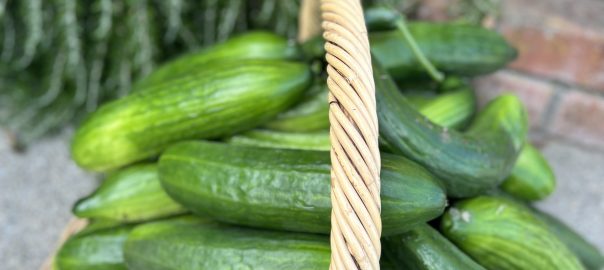Creative with Cucumbers!
Crispy, crunchy, and thirst quenching – cucumbers are a summer supermarket staple. So much so, that some Kiwi kids are said to believe these curcubits grow inside a plastic skin! If you’re not into the shrink-wrap, shopping trolley version of cucumbers (and their gherkin cousin), now is the time to start growing these delicious vegetables in your own tunnelhouse.
Cucumbers require reasonably high temperatures (between 23and 29 degrees Celcius) to thrive. If you live in a warmer part of the country, October is the month to pop the seeds into the tunnelhouse itself. If you’re in a cooler spot, wait until later in the month for this, or delay until November, or even (in the case of mountainous regions) December. Regardless of where you live, if you are still enjoying your autumn and winter planted veges from the tunnelhouse, and plan to do so right through spring, there’s no need to oust them prematurely to make way for cucumber plants. This obliging vegetable will happily wait to be planted until you have space ready for it.
Source
We live in an age where every gardener wants to be a seed saver. That’s a good thing, but sometimes, saving your own cucumber seed doesn’t work out quite as you expect. That’s because many of our favourite varieties are ‘hybrid’ cucs. A hybrid vegetable is the result of two different varieties of plant being deliberately cross-pollinated to create a desired result. Unfortunately, when the seed of the progeny is sown the following year, it is unlikely to produce a vegetable which is identical to its parent. It will have reverted to an earlier variety, and in the case of your cucumber, it will not be the one you were hoping for. If your favourite cucumber variety is labelled ‘F1,’ that’s your clue that it won’t deliver the goods second time round, and that you need to start from scratch with store-bought seeed.
Cucumbers come in a wide range of varieties, so there are plenty of choices. If you are growing in a limited space, choose a compact, bushy variety or one such as the Lebanese cucumber, which produces smaller fruit. If you’re a small household, and want to avoid waste, choose a mini variety such as Cucumber Crunchy F1. And if you’re a pickle-lover, be sure to head to the mini-cuc cousin, the gherkin.
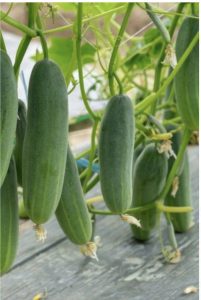
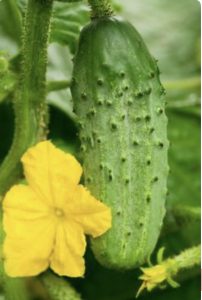
While cucs and gherkins grow readily from seed, they are also widely available in garden centres. If buying potted seedlings, take a magnifying glass with you, and check carefully, on both sides of leaves, for pest insects and their eggs. If there are any signs of invasion, leave the plants on the shelf!
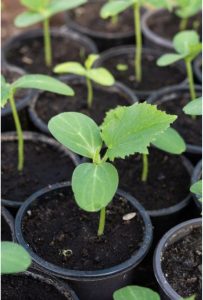
Ground work
Cucumbers (and gherkins) enjoy growing in ground which is fertile, textured, and humus-rich. When preparing a growing spot for them in the tunnelhouse, dig in plenty of safely made, mature, nitrogen-rich compost. Although cucumbers like a little lime, your tomatoes don’t, so if you plan to use the same ground next year for tomatoes, skip the addition of lime (something the cucumber plants will tolerate). Water the ground well, 24 hours prior to sowing seed or planting seedlings.
Cucumbers resent having their roots disturbed, so if you plan to train these climbing plants up stakes or trellis, anchor your supports firmly into the ground before you place the seeds or plants in the soil. If you don’t, you will cut through delicate roots, and your plants my sulk as a result. If you will be using twine to support your growing vines, put these in place before you plant so that you avoid standing on the ground and compressing the soil.
Sowing
Sowing into pots
If you are raising your seeds in containers prior to planting out the resulting seedlings, sow into peat pots (or pots which you make yourself from toxin-free paper). This means that you will be able to plant the seedlings, pots and all, into the tunnel house when the time is right, without disturbing roots. Note: some gardeners have tried using cardboard tubes (such as the sort which come inside kitchen wrap) as planter pots. However, these can be sturdier than they look, and can inhibit root growth before they are ready to decay in the soil.
Fill your seedling pots with quality seed raising or vege mix, water it well, and sow the seed, about 1cm deep, into the growing medium. Cover the seed with loose soil (don’t compress it). If you have a seed raising mat, pop the pots onto it. Covering the pots with a sheet of plastic (at night, only) can speed up germination. If the weather is slow to warm up, water liquid feed onto your seedlings to provide nutrient until they can be transplanted into the tunnelhouse.
Sowing directly into the tunnelhouse
Sow your seeds into prepared ground (see above) in groups of 3. Each group of seed should be sown 60 to 70cm apart. Once the seed germinates and grows on for a week, pluck out the two weakest seedlings from each group, and let the third grow on.
Maintenance
Once the seedlings are established in the tunnelhouse, liquid feed them with nitrogen-rich fertilizer every 3 weeks after flowers appear on the vines. This feed can be brewed by soaking safely made compost with blood and bone, seaweed, and comfrey leaves. Keep the ground beneath the cucumber plants weeded, and the tunnelhouse well-ventilated to encourage the air flow necessary to deter fungal disease. Tie the vines to their supports regularly so that the foliage does not collapse back onto itself.
If you spot signs of ‘rust’ on leaves, snip off the affected foliage and dispose of it in your waste bin (not the compost). If you see signs of aphids, gently squish the insects with your fingers, and treat the foliage (not fruit) with soapy water spray*every 3 days until the infestation reduces or disappears.
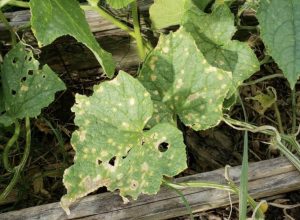
*Make your own soapy water spray by dissolving half a teaspoon of hard bathroom soap in 1 litre of very hot water, cooling the water completely before adding it to a clean spray bottle.
Tips
Most cucumbers require insect pollination to form fruit. Encourage insects into your tunnelhouse by planting insect-friendly flowers around the doors, and by moving one or two potted marigold plants into the greenhouse when they are in bloom.
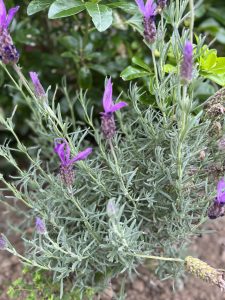
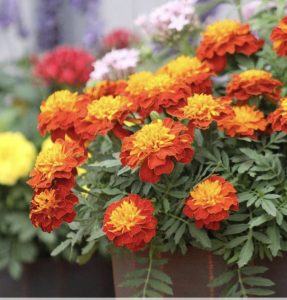
Harvest your cucumbers as soon as they are mature so that the vines do not have to work unnecessarily hard to support them.
When using ties to anchor the cucumber vines to their supports, avoid soft woven, cotton twine. It tends to hold onto moisture and can cause fungal disease to develop in the stems of the plants. Choose strips of nylon pantyhose, instead
Drooping, wilting foliage may not be due to a lack of moisture in the ground. Over-watering can do even more damage as it swamps the soil and prevents oxygen reaching roots. Water only when the ground feels dry up to the second knuckle of your finger. Water deeply, to encourage roots to grow down into cooler ground.
Water your cucumber plants in the early morning so that excess moisture evaporates during the heat of the day and does not collect at night to cause a damp, humid environment.
Discourage disease by always water the plants from the base, avoiding wetting the foliage.
